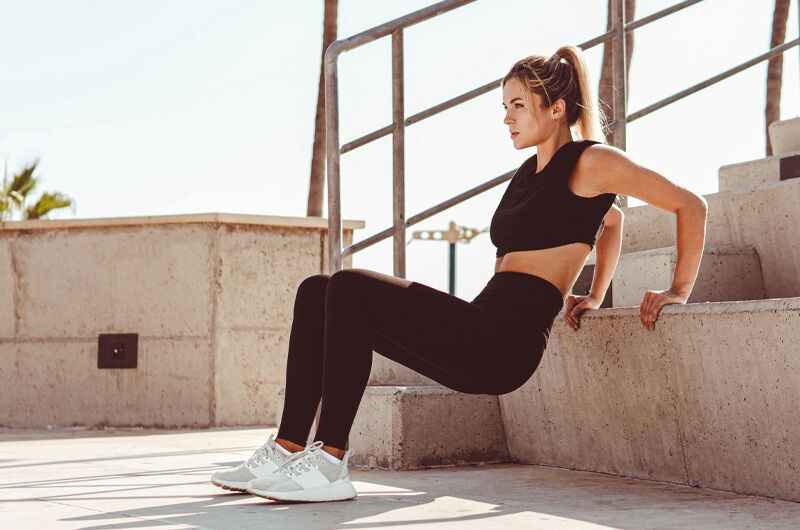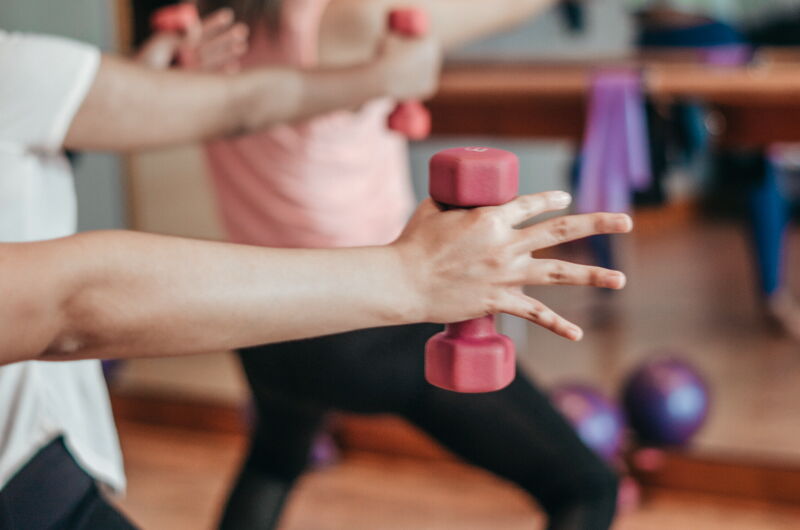Considerations and advice: women's training to prepare for the beach test
The month of April is approaching and, like every year with the arrival of spring, the desire to spend beautiful days of relaxation by the sea begins to be felt. If for some this is an unmissable opportunity to show off an impeccable physical shape, resulting from a healthy lifestyle and maintained over time, for others this moment can be decisive to choose to undertake a path aimed at improving those details of our body that we would like to see different and that we just can't accept.

Often, however, this desire translates into a frantic rush to training and caloric restriction, with the sole objective of fighting the number that appears on the scales. In this article we will see how this approach can be doubly harmful, because it can both put health at risk and, in some, worsen the aesthetic appearance.
How to set up a valid path that can make us improve for the costume test?
Before seeing together some general principles, which can be very useful for improving our state of physical fitness, it is essential to make a premise. It may seem trivial, but it is a concept that often escapes us and leads us into error, namely: every strategy, to be truly effective and sustainable, must be customized and designed for the individual case. Always keeping in mind what has just been said, we can begin to see together what these principles are.
Have a clear idea of what the current situation is
What drives us to want to improve is, most of the time, a feeling of discomfort, due to something that does not fully satisfy us with our appearance. Although this factor is quite common, each circumstance is still unique, and must be framed in a precise way before starting a path. In fact, a well-structured classification phase leads to immediately identifying the factors to be taken into consideration in order not to make mistakes in the development of the training and nutritional strategy. Among the things that a professional can and must evaluate we find:
- The real motivation. Understanding what the need really is, both the one linked to our desires and the one dictated by our lifestyle. Two women, both eager to lose weight, may be experiencing completely different situations. The first could have a stable life and want to improve her body for the summer feeling full of energy, the second could instead lead a very stressful life, and therefore give this path a completely different meaning and weight. We have to take part, even by getting help, both to allow those who create our program to understand well how to act and the direction to take, and to learn to be tolerant with ourselves.
- Anthropometric data and anamnesis. Once we have defined the lifestyle and the environment in which we are going to operate, we can move on to the phase in which we collect all the possible information about our body, including anthropometric data, our sports history and any injuries and pathologies, both present. that you pass. The evaluation of these parameters allows us to understand if we belong to population categories particularly at risk of onset of pathologies, and to define characteristics such as the biotype (gynoid or android). Furthermore, the survey on the level of training allows us to understand what is your ability to face a training program at a given intensity.
- The dietary history. Building a dietary history is essential in order to identify the best approach, also taking into account the training we need to do. Per example, two women (both overweight) may have very different amounts of muscle tissue. This implies that both training and nutrition must be adapted to the individual situation. It is not possible to burn fat if you have little muscle, because fat is oxidized mainly in the mitochondria of muscle cells. It would therefore be better to try to grow muscles, in order to support cardiovascular training.
- The time available. Establishing the time to devote to ourselves on a real basis, without setting intermediate objectives, not respectful of the reality of the facts, is essential to avoid frustration for any failure to reach the goal.
- The ultimate goal. Finally, it is necessary to establish a " final goal", realistic and evaluated for the individual case, which can serve as a motivation and which constantly stimulates us.
As can be seen from the points indicated above, the question is much more complex than how often they want us to believe by selling miraculous and universal recipes, in which everyone's life is revolutionized in the space of a month and we arrive slim and dazzling summer.

The improvement does not depend on a single factor
The improvement of the physical condition is in fact the result of the management of parameters related to training such as volume, intensity and density, but also of a whole series of factors, not secondary at all, dictated by daily rhythms and lifestyle, including work stress, rest and nutrition, for example. This must make us understand that, if we want to improve, we cannot start suddenly to train three hours a day 6 times a week, perhaps even eating very little, because we would certainly end up being super stressed, and it would worsen the quality of our life. In these circumstances, frustration and fatigue could push us to abandon the path and even to adopt behaviors that can make us lose even the progress made. To prevent this from happening, we can implement some small tricks:
- Accept that the change cannot be based on an “ON / OFF” approach, in which you decide to lose 5 kg and stay on a diet for a month, and then return to the previous lifestyle. You must aim at changing your lifestyle and understand that the upcoming summer could be an opportunity to learn to test yourself and gain experience, to be exploited 100% for the next season (and to be satisfied with ourselves all. days, not just in view of the costume test).
- Getting to know each other, for example by understanding that small fluctuations in weight are normal, and that a weight loss or body recomposition process does not have to be linear and downhill, but must be seen as a set of many small adjustments, of which we must learn to observe the trend over time.
- Make sure that our training plan is built on our motor skills and on the current level of experience, taking into account the biotype, so as not to expose ourselves to risk of injury and not to give us the feeling of heaviness in the legs (typical of poorly structured programs).
- Maintain a varied and healthy diet, without definitively eliminating any class of food (except in particular situations in which this approach is suggested by a health professional). In fact, it is important to ensure an adequate intake of macronutrients, micronutrients, fiber, polyunsaturated fatty acids and antioxidants. Rapid weight loss, due to excessive caloric restriction and with the wrong intake of macronutrients, can occur excessively in the muscle tissue, with long-term metabolic repercussions.
- Make sure that diet and training do not become a "prison" that leads us to isolate ourselves: this would be unhealthy and absolutely too stressful for the body.
- Rest adequately, practicing good sleep hygiene, to limit the effects of stress and allow our body to recover.
Practical tips to get started
Given the above, let's try to put these precautions into practice, transforming them into practical advice. An aspect that often must certainly be improved following inactivity is that of the microcirculation. In this regard, adequate physical exercise plays a fundamental role, as in the short term it improves the blood flow to the tissues, facilitating the elimination of accumulated metabolites and the removal of excess fluids, while in the long term it can lead to formation of new capillary beds.

A valid approach for organizing training is to start with total-body sessions, in which you do not focus only on one muscle district, but group all muscle groups with one or two exercises, preferring multi-joint exercises. (such as squats, deadlifts, bench presses, rowing and variations of these exercises). At the beginning of the session it is possible to perform dynamic stretching together with the use of the foam roller which, if used also in the post workout, facilitates muscle recovery.
In order not to make the training monotonous, different circuits can be structured for the different days of the week. The circuits could be structured by alternating the lower and upper body, with a range of repetitions per exercise between 12 and 15, obviously using an adequate load. In this way the series will be longer and the conditioning more oriented to create cardiovascular adaptations. Per more trained people, on the other hand, the target reps can be slightly lower, in the range of 8-12, resulting in the use of a higher load. The ideal in the latter case would be to alternate days of training at a higher intensity with days of training at a lower intensity, and so to have a training stimulus that progresses over time and is always differentiated. Especially for girls with a gynoid build it is advisable to work in buffer: therefore always stopping a few repetitions before failure, and avoiding too much lactic acid work for the lower limbs, in order not to have the sensation of swollen legs at the end of the session. A strategy that can further help avoid this burden is to finish the workout with a walk to help the blood flow from the lower limbs, and rest with the legs raised and resting against the wall at the end of the session. It is also necessary to work on the optimization of diaphragmatic breathing, as this also helps to facilitate venous return and optimize circulation.+ , which could increase inflammation and the consequent stagnation of liquids. A very popular practice is to practice hundreds of repetitions for the abdominal muscles: this is definitely not productive. The visibility of the much desired "turtle" is in fact not due to the number of repetitions we do in the exercises dedicated to this muscle district, but rather to the amount of body fat. Also, add to this the confusion that training the abs with crunches is the only way to train the core. This is not true, as performing multi-joint exercises correctly, even for the upper body, already ensures that the core muscles are trained at 360 degrees.
Conclusions
In the article we have observed just some of the many factors to be taken into consideration in order to start a path of change. As always, the aim of these readings must not be to give universal solutions, but to entice and encourage you to seek further information, also by consulting professionals who can work for us, ensuring that we do not cause errors that can lead us astray and cause damage to health. Always keep in mind that a transformation takes time and will:what may seem like a short path to wearing a costume, or a dress that you particularly like, could be much more than that, and put us in front of great difficulties. Precisely for this reason it is important not to fall into pitfalls, such as focusing only on the weight and not giving the right importance to the path, but instead acquiring a broader vision, and being guided in this path.
Bibliography
Tarnanen SP, Siekkinen KM, Häkkinen AH, Mälkiä EA, Kautiainen HJ, Ylinen JJ. Core muscle activation during dynamic upper limb exercises in women. J Strength Cond Res. 2012 Dec; 26 (12): 3217-24. doi: 10.1519 / JSC.0b013e318248ad54. PMID: 22222323.
Hendricks S, Hill H, Hollander SD, Lombard W, Parker R. Effects of foam rolling on performance and recovery: A systematic review of the literature to guide practitioners on the use of foam rolling. J Bodyw Mov Ther. 2020 Apr;24(2):151-174. doi: 10.1016/j.jbmt.2019.10.019. Epub 2019 Nov 2. PMID: 32507141.
McCarthy D, Berg A. Weight Loss Strategies and the Risk of Skeletal Muscle Mass Loss. Nutrients. 2021 Jul 20;13(7):2473. doi: 10.3390/nu13072473. PMID: 34371981; PMCID: PMC8308821.
Salt DG. Neural adaptation to resistance training. Med Sci Sports Exerc. 1988 Oct;20(5 Suppl):S135-45. doi: 10.1249/00005768-198810001-00009. PMID: 3057313.
